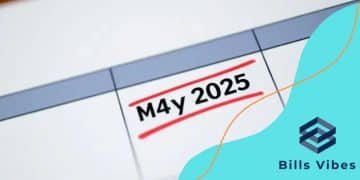Emergency fund tips 2025: secure your financial future

An emergency fund is a dedicated savings account with three to six months’ worth of living expenses, set aside for unexpected financial emergencies to provide stability and peace of mind.
Emergency fund tips 2025 can help you achieve stability in times of uncertainty. Have you ever faced an unexpected expense that caught you off guard? Let’s explore how to prepare for such moments.
Understanding the importance of an emergency fund
Understanding the importance of an emergency fund is crucial for anyone looking to achieve financial stability. An emergency fund acts as a safety net, providing security when unexpected expenses arise. These can include anything from sudden car repairs to medical bills.
Why You Need an Emergency Fund
Having an emergency fund allows you to handle life’s unexpected turns without financial stress. Many people find themselves unprepared for emergencies, leading to debt or financial hardship. When you have a cushion of savings, you can avoid high-interest loans or credit card debt.
Key Benefits:
- Reduces financial stress during emergencies
- Prevents you from going into debt
- Offers peace of mind knowing you are protected
Another important aspect is how much money you should aim to set aside. Experts often recommend saving enough to cover three to six months’ worth of expenses. This gives you ample time to regroup and reassess your finances if something goes wrong. In times of uncertainty, this fund will become your best friend, keeping you afloat.
Furthermore, it’s essential to regularly contribute to your emergency fund. Set up automatic transfers to make building your savings a habit. Consider this fund a priority, just like paying rent or utilities. The sooner you start, the more secure your financial future will be.
As you build your emergency fund, be mindful of where you keep this money. Ideally, it should be in a savings account that offers easy access, while still earning some interest. This way, your fund is available when you need it, but it’s not so accessible that you’re tempted to dip into it for non-emergencies.
In conclusion, understanding the importance of an emergency fund can transform your financial outlook. It’s an essential step in creating a healthy financial life, ensuring that you are ready for whatever unexpected situation comes your way.
How much money should you save?
Determining how much money you should save for your emergency fund can feel overwhelming, but it is essential for your financial security. The right amount often depends on your personal situation, including monthly expenses, income, and lifestyle.
General Guidelines
Most financial experts recommend saving between three to six months’ worth of living expenses. This target provides a buffer, allowing you to manage unforeseen circumstances without stress.
- Determine your monthly essential expenses.
- Multiply that amount by three to six.
- Consider factors like job stability and personal circumstances.
For example, if your monthly expenses total $2,500, aim for an emergency fund between $7,500 and $15,000. It’s prudent to start with a goal that integrates your personal needs and comfort level.
As you create your savings plan, think about assessing and updating your emergency fund regularly. Changes in income, job status, or family size can impact how much you need to save. Regular adjustments ensure your fund meets current circumstances, making it a more effective safety net.
Tailoring Your Savings Goal
Consider additional factors when setting your savings target. For instance, if you are self-employed or have an irregular income, you might want to lean towards six months or more in your fund. This approach gives you more flexibility and security during lean periods.
Don’t forget about unexpected costs such as car repairs or medical emergencies. It’s wise to add a small buffer to your savings target for additional peace of mind.
Choosing the right account for your emergency fund

Choosing the right account for your emergency fund is a critical step in ensuring that your savings are both safe and accessible. With so many options available, it’s important to understand what features work best for your needs.
Types of Accounts
When considering options, most people think of traditional savings accounts, but other choices can be beneficial as well. A few good options include:
- High-yield savings accounts: These accounts typically offer a higher interest rate than regular savings accounts, helping your money grow more quickly.
- Money market accounts: This type of account often allows limited check-writing abilities while still providing competitive interest rates.
- Certificates of deposit (CDs): These accounts require you to lock your money away for a set term, but they can offer even higher interest rates compared to standard savings accounts.
Finding the right account involves more than just interest rates, though. Consider factors like fees, minimum balance requirements, and access to your money. You want an account that allows you to withdraw cash easily without incurring penalties. This ensures you can access your emergency fund quickly when you need it.
Evaluating Your Choices
As you evaluate your options, checking the financial institution’s reputation is also essential. Look for trusted banks or credit unions with a history of customer service. Researching online reviews or asking friends and family for recommendations can help you make a better choice.
Additionally, consider online banks, which often offer better rates than traditional brick-and-mortar banks due to lower overhead costs. By being selective about where you keep your emergency fund, you can maximize your savings potential while ensuring peace of mind.
Tips for building your financial cushion quickly
Building your financial cushion quickly is essential for those who want a robust emergency fund. By following a few strategic tips, you can grow your savings faster and more efficiently.
Start with a Savings Goal
The first step is to set a clear savings goal. Determine how much you aim to save for your emergency fund. It’s recommended to have at least three to six months’ worth of living expenses saved. Knowing your target will help you stay motivated and focused.
- Calculate your monthly essential expenses.
- Multiply that by three to six months.
- Use this figure as your savings goal.
Once you have a target, create a plan to reach it. Break your goal into smaller monthly milestones. This makes the process feel less overwhelming and keeps you on track.
Reduce Unnecessary Expenses
Another effective way to build your financial cushion is by cutting costs. Take a close look at your daily spending habits. Identify areas where you can save money. This could include:
- Dining out less frequently.
- Canceling unused subscriptions.
- Shopping with a list to avoid impulse buys.
Redirect the money you save into your emergency fund. Even small changes can lead to significant savings over time.
Automate Your Savings
Consider setting up automatic transfers from your checking account to your savings account. By doing this, you pay yourself first before spending on other things. This automated process can make saving effortless and consistent.
You might also explore side jobs or freelance gigs to boost your income. Using extra earnings exclusively for your emergency fund can rapidly accelerate your savings.
By combining these strategies, you can efficiently build your financial cushion. Staying committed to your plan, adjusting your budget, and automating savings will help you achieve your goal quicker than you might think.
Common mistakes to avoid with emergency savings
When building your emergency savings, it’s crucial to avoid common mistakes that can hinder your progress. Many people unknowingly make errors that can delay or derail their saving efforts. Understanding these pitfalls can help you stay on track and achieve financial security.
1. Not Having a Clear Goal
One mistake is failing to set a clear savings goal. Without a specific amount in mind, it can be easy to lose focus. Establish a target that represents three to six months’ worth of expenses. This clarity gives you direction and motivation.
Another common error is using your emergency savings for non-emergencies. It’s important to maintain discipline and only use these funds for genuine emergencies, such as unexpected car repairs or medical bills. This way, your fund remains intact for real crises.
2. Inadequate Contributions
Some may also underestimate how much to save each month. It’s easy to think small contributions will add up over time. However, to build your fund quickly, consider automating larger monthly transfers. This can ensure consistent growth without relying on your willpower.
3. Keeping Fund in the Wrong Account
Another mistake is choosing the wrong type of account for your savings. Some people place their funds in accounts that don’t offer accessibility or high interest. Instead, look for high-yield savings accounts or money market accounts that provide both safety and growth potential.
4. Forgetting to Reassess Your Needs
Additionally, failing to periodically reassess your emergency fund can be detrimental. Life changes such as a new job, marriage, or having children can alter your financial needs significantly. It’s wise to review your fund regularly to ensure it reflects your current situation.
By steering clear of these common mistakes, you can effectively build and maintain your emergency savings. Staying disciplined and aware of your savings habits will help you achieve your financial goals.
FAQ – Frequently Asked Questions about Emergency Funds
What is an emergency fund?
An emergency fund is a savings account set aside for unexpected expenses, like medical bills or car repairs, providing financial security.
How much should I save in my emergency fund?
You should aim to save three to six months’ worth of living expenses to ensure you can cover essential costs during a financial emergency.
Where should I keep my emergency fund?
It’s best to keep your emergency fund in a high-yield savings account or money market account, where it earns interest while remaining easily accessible.
What common mistakes should I avoid with my emergency savings?
Avoid not setting a clear savings goal, using the funds for non-emergencies, and not reviewing or adjusting your savings needs regularly.






